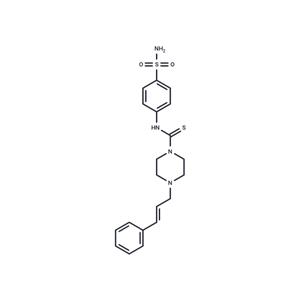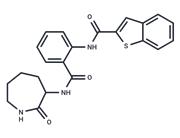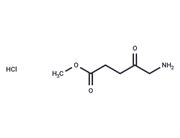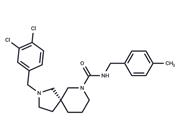| Name | LF3 |
| Description | LF3 is a specific inhibitor of canonical Wnt signaling by disrupting the interaction between β-catenin and TCF4 (IC50 < 2 μM) |
| Animal Research | Unsorted GFPlow and GFPhigh SW480 cells (1 × 10^4) were subcutaneously injected into the back skin of NOD/SCID mice. Tumor growth was monitored over a period of 45 days. For therapy, LF3 was administered i.v. at 50 mg/kg body weight for three rounds over 5 consecutive days, with 2-day breaks[1]. |
| In vitro | LF3 inhibited Wnt/β-catenin signals in cells with exogenous reporters and in colon cancer cells with endogenously high Wnt activity. LF3 also suppressed features of cancer cells related to Wnt signaling, including high cell motility, cell-cycle progression, and the overexpression of Wnt target genes[1]. |
| In vivo | LF3 reduced tumor growth and induced differentiation in a mouse xenograft model of colon cancer.LF3 is a specific inhibitor of canonical Wnt signaling with anticancer activity[1]. |
| Storage | Powder: -20°C for 3 years | In solvent: -80°C for 1 year | Shipping with blue ice. |
| Solubility Information | DMSO : 32 mg/mL (76.82 mM)
|
| Keywords | β-catenin | Beta catenin | LF 3 | LF-3 | inhibit | LF3 | Inhibitor |
| Inhibitors Related | Urea | PRI-724 | Wnt pathway activator 1 | L-quebrachitol | MSAB | EMT inhibitor-1 | Wogonin | CHIR-99021 | XAV-939 | Nefopam hydrochloride | KY-05009 | Bisdemethoxycurcumin |
| Related Compound Libraries | Bioactive Compound Library | Anti-Ovarian Cancer Compound Library | Neuroprotective Compound Library | Inhibitor Library | Anti-Prostate Cancer Compound Library | Stem Cell Differentiation Compound Library | Bioactive Compounds Library Max | Cytoskeletal Signaling Pathway Compound Library | Anti-Cancer Compound Library | Neuronal Differentiation Compound Library |

 United States
United States



